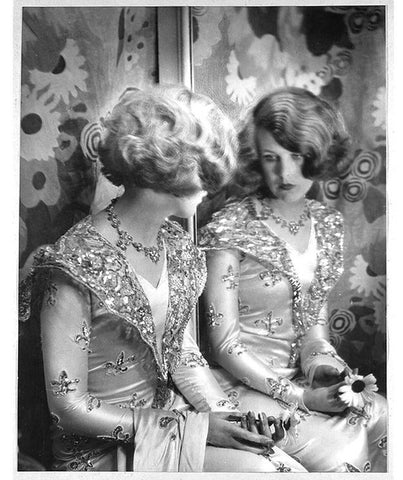We can't discuss the 1920s without giving a mention to the young bohemian London aristocrats, artists and socialites known as the Bright Young Things, effectively the 20th Century's first youth movement!

This group were wrapped up in scandal involving wild parties, drug use, flamboyance, excess, fancy dress and night-time treasure hunts! They were chased by the paparazzi and started the modern cult of celebrity.

It was actually a group of girls that started these escapades around London and later the boys joined in. They frequented the jazz clubs and cocktail bars of London and had weekend long house parties in the country. They were rebelling against the morbid mood of Europe following WWII, an event they were too young to have fought in. They expressed themselves through clothing and sexuality.

Stephen Tennant was one of the "brightest" members, dressing androgynously like an earlier David Bowie. He was said to be the model for Evelyn Waugh’s Sebastian Flyte in Brideshead Revisited, Miles Malpractice in his Vile Bodies, and Cedric Hampton in Nancy Mitford’s Love in a Cold Climate. Vile Bodies, adapted as the 2003 film 'Bright Young Things', is a satirical look at this scene from an inside member.

Cecil Beaton began his career in photography by documenting this set, of which he was a member.


 A group of BYT's including Cecil Beaton and Tallulah Bankhead in 1927
A group of BYT's including Cecil Beaton and Tallulah Bankhead in 1927
Beaton published 'The Book of Beauty' in 1930 which was a book of photographs of some of the most beautiful women of the era including Gloria Morgan Vanderbilt and Consuelo Vanderbilt.

The group's costume parties were unlike any seen previously, especially for conservative England. The group dressed however they wanted in a combination of feminine, androgynous and genderless style as well as experimentation with make-up. Men and women wore dresses and suits with bright details, flashy headdresses, and unusual accessories. It was total creative freedom.

Loelia Ponsonby, soon to be Duchess of Westminster, hosted the 'Dream of Fair Women' ball in 1928. The guests were dressed in a tableau of futuristic fashions designed by Cecil Beaton. Some of the outfits were called 'the huntswoman of 1960', 'the bather of the future', 'the nun/ bridge-player of 1980' or 'Ascot 2000'. Cecil's sister Baba was dressed as 'the bride of 2028' in a white and silver embroidered satin confection along neoclassical lines, adorned with a vast Elizabethan lace collar.


Another party was the Circus ball hosted by fashion designer Norman Hartnell in 1929, who dressed as the ringmaster.

As the 20s drew to a close and economic decline and mass unemployment occurred, the public grew irritated with the group's wild partying.
![]()
The Red and White Ball of November 1931 was perhaps the ‘party too far’. The dress code was ‘Red and White’; even the food was red and white. This whole show of excess was received with hostility and irritation by the media. Denounced by the press, this signalled the end for the ‘Bright Young Things’. The party was held at Holford House and Michael Harrison described it as:
“At this famous party, at which Arthur wore white angel-skin pyjamas, white elbow-length kid gloves, ruby-and-diamond bracelets and carried a muff of white narcissi, all the Bright Young Things turned up, everyone in red-and-white. Evan Morgan was in a scarlet toga, his young gentleman friend was in a white ski-suit, with a white fur shako. Even the cigarettes were red as well as white, and only red and white things were there to eat: lobsters, strawberries, things like that."

In the aftermath of the backlash, there were to be no more public extravaganzas. Of course the rich still lavished money on balls and parties, but they were “Society” affairs that the middlebrow-press regarded with approval. London would not again witness such openly “gay” gatherings for a couple of generations.

Though shrouded in scandal, they contributed greatly to arts and culture and we have Cecil's incredible photos as proof. The National Portrait Gallery held an exhibition of his work in 2020 entitled 'Cecil Beaton's Bright Young Things'. The curator Robin Muir commented that the group created ‘a deliriously eccentric, glamorous and creative era of British cultural life, combining high society and the avant-garde, artists and writers, socialites and partygoers, all set against the rhythms of the Jazz Age’.

